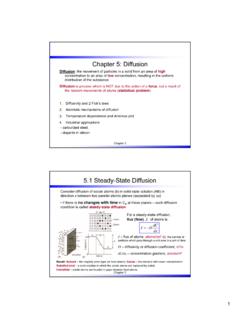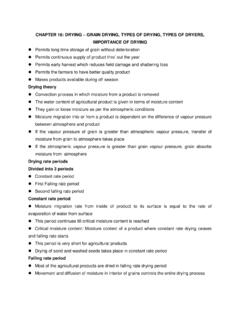Transcription of Hazard Prevention and Control in the Work Environment ...
1 Hazard Prevention and Control in the Work Environment : Airborne Dust WHO/SDE/ Chapter 1 - Dust: Definitions and Concepts Airborne contaminants occur in the gaseous form (gases and vapours) or as aerosols. In scientific terminology, an aerosol is defined as a system of particles suspended in a gaseous medium, usually air in the context of occupational hygiene, is usually air. Aerosols may exist in the form of airborne dusts, sprays, mists, smokes and fumes. In the occupational setting, all these forms may be important because they relate to a wide range of occupational diseases. Airborne dusts are of particular concern because they are well known to be associated with classical widespread occupational lung diseases such as the pneumoconioses, as well as with systemic intoxications such as lead poisoning, especially at higher levels of exposure.
2 But, in the modern era, there is also increasing interest in other dust-related diseases, such as cancer, asthma, allergic alveolitis, and irritation, as well as a whole range of non-respiratory illnesses, which may occur at much lower exposure levels. This document aims to help reduce the risk of these diseases by aiding better Control of dust in the work Environment . The first and fundamental step in the Control of hazards is their recognition. The systematic approach to recognition is described in Chapter 4. But recognition requires a clear understanding of the nature, origin, mechanisms of generation and release and sources of the particles, as well as knowledge on the conditions of exposure and possible associated ill effects. This is essential to establish priorities for action and to select appropriate Control strategies.
3 Furthermore, permanent effective Control of specific hazards like dust needs the right approach to management in the workplace. Chapters 1 and 2, therefore, deal with the properties of dust and how it causes disease. Chapter 3 discusses the relationship of management practice and dust Control . Dust as an occupational Hazard According to the International Standardization Organization (ISO 4225 - ISO, 1994), "Dust: small solid particles, conventionally taken as those particles below 75 m in diameter, which settle out under their own weight but which may remain suspended for some time". According to the "Glossary of Atmospheric Chemistry Terms" (IUPAC, 1990), "Dust: Small, dry, solid particles projected into the air by natural forces, such as wind, volcanic eruption, and by mechanical or man-made processes such as crushing, grinding, milling, drilling, demolition, shovelling, conveying, screening, bagging, and sweeping.
4 Dust particles are usually in the size range from about 1 to 100 m in diameter, and they settle slowly under the influence of gravity.". However, in referring to particle size of airborne dust, the term "particle diameter" alone is an over simplification, since the geometric size of a particle does not fully explain how it behaves in its airborne state. Therefore, the most appropriate measure of particle size, for most occupational hygiene situations, is particle aerodynamic diameter, defined as "the diameter of a hypothetical sphere of density 1 g/cm3 having the same terminal settling velocity in calm air as the particle in question, regardless of its geometric size, shape and true density." The aerodynamic diameter expressed in this way is appropriate because 1.
5 Hazard Prevention and Control in the Work Environment : Airborne Dust WHO/SDE/ it relates closely to the ability of the particle to penetrate and deposit at different sites of the respiratory tract, as well as to particle transport in aerosol sampling and filtration devices. There are other definitions of particle size, relating, for example, to the behaviour of particles as they move by diffusion or under the influence of electrical forces. But these are generally of secondary importance as far as airborne dust in the workplace is concerned. In aerosol science, it is generally accepted that particles with aerodynamic diameter >50 . m do not usually remain airborne very long: they have a terminal velocity >7cm/sec. However, depending on the conditions, particles even >100 m may become (but hardly remain) airborne.
6 Furthermore, dust particles are frequently found with dimensions considerably <1 m and, for these, settling due to gravity is negligible for all practical purposes. The terminal velocity of a 1- m particle is about mm/sec, so movement with the air is more important than sedimentation through it. Therefore, summarizing in the present context, it is considered that dusts are solid particles, ranging in size from below 1. m up to at least 100 m, which may be or become airborne, depending on their origin, physical characteristics and ambient conditions. Examples of the types of dust found in the work Environment include: mineral dusts, such as those containing free crystalline silica ( , as quartz), coal and cement dusts;. metallic dusts, such as lead, cadmium, nickel, and beryllium dusts.
7 Other chemical dusts, , many bulk chemicals and pesticides: organic and vegetable dusts, such as flour, wood, cotton and tea dusts, pollens;. biohazards, such as viable particles, moulds and spores Dusts are generated not only by work processes, but may also occur naturally, , pollens, volcanic ashes, and sandstorms. Fibrous dusts, such as asbestos and other such materials, have been shown to present special health problems primarily related to the shape of the particles. In relation to health, particles with diameter < 3 m, length > 5 m, and aspect ratio (length to width) greater than or equal to 3 to 1, are classified as "fibres" (WHO, 1997). Examples of fibres include asbestos (comprising two groups of minerals: the serpentines, , chrysotile, and the amphiboles, , crocidolite - "blue asbestos").
8 Other examples include synthetic fibrous materials such as rockwool (or stonewool) and glass wool, as well as ceramic, aramid, nylon, and carbon and silicon carbide fibres. Although in occupational hygiene, the term "airborne dust" is used, in the related field of environmental hygiene, concerned with pollution of the general atmospheric Environment , the term "suspended particulate matter" is often preferred. The aerodynamic behaviour of airborne particles is very important in all areas of measurement and Control of dust exposure. Detailed information, including the relevant 2. Hazard Prevention and Control in the Work Environment : Airborne Dust WHO/SDE/ physics, can be found in the specialized aerosol science literature (Green and Lane, 1964;. Fuchs, 1964; Hinds, 1982; Vincent, 1989 and 1995; Willeke and Baron, 1993).
9 3. Hazard Prevention and Control in the Work Environment : Airborne Dust WHO/SDE/ Penetration and deposition of particles in the human respiratory tract For better understanding of this section, a schematic representation of the respiratory system is presented in Figure 1-1, indicating the different regions, namely, nasopharyngeal (or extrathoracic region), tracheobronchial region and alveolar region. Figure 1-1 - Schematic representation of the human respiratory tract Particles small enough to stay airborne may be inhaled through the nose (nasal route) or the mouth (oral route). The probability of inhalation depends on particle aerodynamic diameter, air movement round the body, and breathing rate. The inhaled particles may then either be deposited or exhaled again, depending on a whole range of physiological and particle-related factors.
10 The five deposition mechanisms are sedimentation, inertial impaction, diffusion (significant only for very small particles < m), interception, and electrostatic deposition. Sedimentation and impaction are the most important mechanisms in relation to inhaled airborne dust, and these processes are governed by particle aerodynamic diameter. There are big differences between individuals in the amount deposited in different regions (Lippmann, 1977). The largest inhaled particles, with aerodynamic diameter greater than about 30 m, are deposited in the airways of the head, that is the air passages between the point of entry at the lips or nares and the larynx. During nasal breathing, particles are deposited in the nose by filtration by the nasal hairs and impaction where the airflow changes direction.












